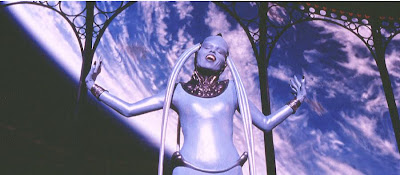Cinema, as goes the cliché, is a visual medium. Yet few masters have achieved cinematic nirvana of making a film with the least dialogues (ideally dreaming of none). For a first time director to even aspire to do that, takes courage. For him to succeed and hold the audience's attention for an hour and a half without one word uttered and the bare minimum music, takes tremendous skill. If you see Luc Besson's 'The Last Combat' (TLC) (made when he was all of 24), you'll realize with delight that he does not lack either.
A 24 year Luc Besson broke through the barriers to make perhaps his best film ever, 'The Last Combat'.
Yet in the rooster of World Cinema greats, you will rarely find this films mention. The problem lies in the basic premise and setting, which it borrows from 'Mad Max 2' (The Road Warrior). And though there are similarities, the lawless post-apocalyptic world, the glider, the barren desert landscape, 'The Last Combat' pushes filmmaking into horizons least explored previously, or hence. While Mad Max 2 exults in grand landscapes and panoramic shots, TLC's world is a closed space, a city with broken buildings and a ruthless villain. Thankfully, this overlooked masterpiece by critics, has been rescued by audiences and has acquired cult status.
In the underbelly of human civilization, its subway.
Besson's love of closed spaces brings us to his next, 'Subway'. This time he gets into the underbelly of civilisation, its subway, and brings together characters that live in the fringes of society diving deep down into their world. A thief on the run with documents after breaking into the safe of a rich man, takes refuge with weird characters that inhabit the subway in this bizzare comic caper where he falls in love with the rich man's wife. In 'Le Grand Blue' he is “falling without slipping” as a character describes diving, yet this film about deep sea divers, does not live up to the promise of its predecessors, perhaps because the subject was too close to his heart (his parents were scuba diving instructors; but for an accident at age 18, he'd have become a marine biologist) for him to film objectively.
A trigger-happy, beautiful woman with a license to kill, what else could scintillate a man's fantasy more. Yet, 'Nikita' is much more.
He corrects this mistake in 'Nikita', which brings back his mad-cap flair for stylistic violence. A convict sentenced to death is kept alive and trained for three years to be a government assassin. Though Besson opens up in the film, roaming the streets of Paris and Venice freely, his confinement this time is the mind and mixed emotions of his femme fatale. The film became a sensation, resulting in a hit American TV series (which he wrote) and more importantly, opening up his doors to America aka Hollywood.
His first American film 'Leon', besides some stunning cinematography of violence, is a study of a strange relationship between a hitman (played by his regular Jean Reno) and a 12 year old girl (Mathilda, played by 11 year old Natalie Portman) he has rescued. The girl wants to become a hitman like him out of vengeance. Their relation is absurd and uneasy as on one side it is paternal, and on the other side the under-aged girl professes her love for the cold-blooded, calculative, yet slightly retarded hitman. The landscape is New York, the man behind directing the camera, unmistakably Besson.
This time the female fatale is again a woman, only a much younger one. Natalie Portman aged 11.
Ironically, 'Leon', meant to be a filler to utilize his team because the shooting of 'The Fifth Element' was delayed due to unavailability of dates from Bruce Wills, is today more popular than the later, which is often seen as the beginning of the decline of Besson. Hollywood had taken a liking for this French stylist (many like Tarantino borrow elements from his absurdist violence and its corresponding style), and perhaps this adulation did not do him good. Aside some grand visions of the future (flying cars, spaceship as hotel etc.), 'The Fifth Element' lacked the depth of character and story that were a hallmark of his previous films. The pleasurable confinement of enclosed spaces (physically and of the mind) had given way to some blank open spaces and spectacular special effects.
Scream all you want, but all effects and no substance... do not a good film make. 'The Fifth Element' began the decline of Besson.
The rest of his career, both in Hollywood and France, with the exception of 'Angel-A' so far has been given way to too much style and action (the Transporter series) and mindless comedy (the 'Taxi' series), than the substance of his earlier films.
Besson's main theme, in almost all his previous stories, is the individual. He is not interested in the grand plot, or the grand sweep surrounding the main characters. All that he is interested in are the protagonists, usually one, two, or three and he paints their portrait like a painter paints his masterpieces, delicately and intimately. It is as if his voyeuristic camera is making intimate love to their characters.
He has hence been a disappointment to his true fans. Considered a pivotal figure in the Cinéma du look movement, a specific style of film being made in the '80s and early 1990s- Luc Besson's commercial success, cult following and critical controversies – has seen his films being positioned at two extremes by critics: on one hand: générationnel, a defining moment in the culture and on the other hand: Hollywood trash. Yet, at age 50, it is too early to write him off as the latter. Indeed, the last combat of Besson, may have just begun.








0 comments:
Post a Comment